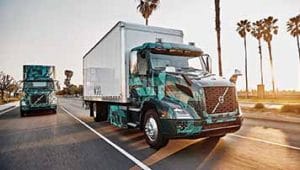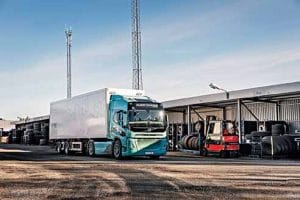Volvo Trucks is working on an electrification strategy that would include the strengthening of its existing e-trucks and new exciting launches.
Story by Team CV
Europe is no stranger to electric truck experiments. Every European CV major has invested substantial sums and resources for the cause. Much has been achieved in a way to alternate fuel strategy in terms of CO2 emission reduction. More needs to be achieved to attain a sustainable zero emissions goal as more and more trucks hit the roads in Europe with motors and battery packs onboard to complement urban delivery fleets and serve customers like big retail chains, municipalities among others. Aiming at a complete fossil-free product range by 2040, Volvo Trucks is pushing its e-truck range at various levels and in various continents. Pushing its e-truck portfolio and electrification strategy to encompass new application areas and possibilities, the Swedish CV major is expected to achieve good progress on the alternate fuel front this year. Said to be working on some ultimate game changing moves in the shift to zero-emission mobility, and to provide a sustainable goal for transport mobility against the backdrop of extreme climate events, it is known to work closely with its suppliers and other partners. The clear aim is claimed to be about reducing operating costs for customers and higher efficiencies for the end users.
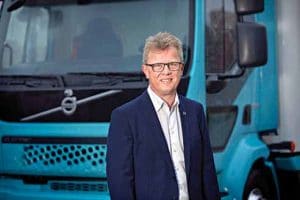 Proving to be exciting animals, the current fleet of e-trucks from Volvo — the e-FL, e-FE and the e-VNR, are showing the promise of being multiple times more efficient than their diesel counterparts at moving the same freight. The electric versions of Volvo FL and FE deployed in select European markets as seeding units are helping end users such as restaurants or stores to reduce inventory. According to Jonas Odermalm, Head, Product Strategy — FL & FE trucks, Volvo, their quieter operation-ability is enabling them to operate at off-hours or in the middle of the night unlike diesel trucks that would be not allowed to operate. This would invariably help such businesses to save money. Roger Alm, President, Volvo Trucks, is of the opinion that Volvo’s work in the area of e-trucks is taking them closer to fulfilling their customers need for sustainability. It is aiding many transport operators working hard to reduce their environmental footprint and improving drivers’ working environment. Most of all, added Alm, our work in the area of e-trucks is paving way for quieter and cleaner transports.
Proving to be exciting animals, the current fleet of e-trucks from Volvo — the e-FL, e-FE and the e-VNR, are showing the promise of being multiple times more efficient than their diesel counterparts at moving the same freight. The electric versions of Volvo FL and FE deployed in select European markets as seeding units are helping end users such as restaurants or stores to reduce inventory. According to Jonas Odermalm, Head, Product Strategy — FL & FE trucks, Volvo, their quieter operation-ability is enabling them to operate at off-hours or in the middle of the night unlike diesel trucks that would be not allowed to operate. This would invariably help such businesses to save money. Roger Alm, President, Volvo Trucks, is of the opinion that Volvo’s work in the area of e-trucks is taking them closer to fulfilling their customers need for sustainability. It is aiding many transport operators working hard to reduce their environmental footprint and improving drivers’ working environment. Most of all, added Alm, our work in the area of e-trucks is paving way for quieter and cleaner transports.
Volvo e-FL, e-FE and e-VNR
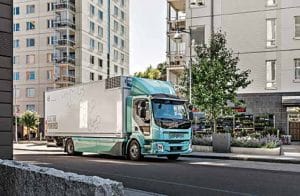
Announcing its electrification efforts in 2019 with the e-FL and e-FE trucks in 2019, Volvo has gained good ground until the start of 2021. Upon an amount of research at the fleet and end customer level in Europe, Volvo Trucks saw an opportunity to provide solutions to some unique challenges with its trucks. Challenges like daytime delivery hiccups, which called for the end customers to invest in higher inventory. With e-truck for urban regions, the end customers could save the need to have double amounts of all ingredients in the store. They could hope for shipment in time. They could hope to be more efficient and address their fear of losing out on their clients.
The fact that urban Trucks’ often travel at lesser speeds than their long-haul counterparts saw Volvo Trucks’ develop e-trucks like the e-FL and e-FE to save much energy and reduce emissions. A look at the e-FL and e-FE trucks with city distribution and refuse operations, and it will be clear. The e-FL is a two-axle truck with a GVW of up to 16-tonnes. Producing 248 hp, it comes in two different wheelbases and a battery capacity that enables an operating range of up to 300 km. The e-FE, at the other end, is a three-axle truck with a GVW of up to 27-tonnes. Producing 496 hp and having an operating range of up to 200 km, it is being used for waste collection, light construction transports and deliveries in urban regions. Given the low average speed of about 20.1 kmph and a load averaging about 15 per cent of its maximum load, an e-FE waste collection truck is turning out to be more efficient than its diesel equivalent. This, since the average efficiency of diesel at such a low-load level is claimed to be about 20 per cent. In comparison, the e-truck has the ability to exhibit about 80 per cent efficiency. Add brake energy recuperation and more efficient auxiliary drives, and the level elevates itself to about five times that of a diesel equivalent.
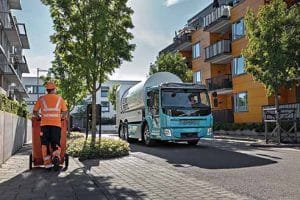
In North America, the e-VNR is attracting takers on the premise that it is available in three configurations (a single-axle straight truck with a gross vehicle weight rating of 15-tonnes and two tractor configurations of 29-tonne GCWR and 37-tonne GCWR). Rated at 455 hp, the e-truck, with its driveline very similar to that of the e-FE, is fitted with 264 kWh lithium-ion batteries. These could be charged up to 80 per cent within 70 minutes and offer an operating range of up to 241 km. Aimed at urban transportation, the e-VNR is addressing the heightened energy needs. With even things that worked before with mechanical technology being made electronic or digital — like mobile devices and more, the e-VNR is helping US urban fleets to seek the advantage of e-trucks with their ability to haul the same loads as a diesel truck equivalent, saving costs and upping efficiency in the process. Commercially available for customer applications and driving cycles with local and regional distribution ranges, the e-VNR, according to Peter Voorhoeve, President, Volvo Trucks North America, is a result of having worked alongside our fleet customers to plan beyond the vehicle and have developed an entire support system to ensure the vehicle meets their needs day-in and day-out.
Vision 2021
With the e-FE, e-FL and e-VNR fairly well-entrenched, Volvo Trucks, as part of its electrification strategy, is expanding the envelope. It is looking at the electrification of its FH, FM and FMX heavy-duty truck range. With a gross combination weight of up to 44-tonnes and the range of up to 300 km depending on the battery configuration, the electrification of FH, FM and FMX range would unleash many new application possibilities without having to pay for a significant carbon footprint. Averred Alm, that Volvo Trucks would be putting on sale the electric versions of these trucks this year in Europe and start volume production in next year. Aware that a swift transition from fossil fuels to alternatives is not an easy job as conditions vary for transporters and markets, the Swedish CV major is looking at the entire ecosystem as well as the key areas where it could go to work to make such a transition easier. It is in particular looking at areas such as financial incentives, access to charging infrastructure and type of transport operations. Considering the time it would take for transporters to transition to electric, Volvo Trucks, according to Alm, is keeping an eye on even the most minute market shifts. It is also preparing for a stage where the preference would be for a mixed fleet powered by different fuels. At least during the transition period.
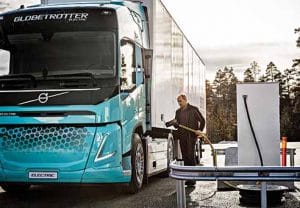
Having designed a chassis for its trucks such that they could be used for diesel as well as alternate fuel drivelines, Volvo Trucks, has done a lot of work to power its alternate fuel strategy on a long-term basis. Its customers therefore could choose to have the same model with electric, gas or diesel driveline. Averred Alm, that such a move made it easier for them to offer the same product characteristics like driver environment, reliability and safety across drivelines. Of the opinion that electric is an investment for the future, Alm mentioned that zero tailpipe emissions and lower noise of an electric truck opens up many new possibilities to transport goods. e-trucks can now carry goods where regular trucks can’t. Creating more opportunities to perform a wide range of transports assignments during off-peak hours and improve fleet as well as space utilisation, e-trucks, because of their lower noise levels also make for a smoother drive. Their significantly lower vibration levels in the cab make for better safety.
Ideal for urban transport because the electric motor fitted in the truck offers a smooth and seamless power delivery, e-trucks are part of the Volvo Trucks larger scheme of things in its journey to a complete fossil-fuel free product range by 2040 no doubt. The CV major is well aware of the need for battery and hydrogen-electric vehicles with a more extended range. Expressed Jessica Sandström, Senior Vice President, Product Management, Volvo Trucks, “We are committed to driving the development of sustainable transport solutions.” “We are here to enable an easy and viable transition to electrified transports,” she added.




